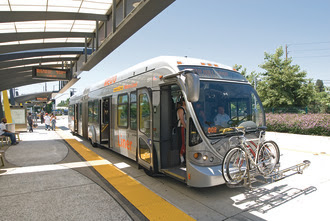The difficulty in achieving this has less to do with the technical challenges or even the cost, and mostly about the political will to do it. Carving out street space for transit vehicles to create dedicated bus lanes - which can also serve a great dual purpose as bike lanes - is relatively easy to do from a technical standpoint. It typically requires converting a travel lane in each direction for exclusive use of transit vehicles, which can include buses, streetcars, or light rail vehicles.
 |
| Dedicated bus lane in New York City (NYCDOT) |
While these kind of changes do cost money, the cost of gradually introducing dedicated transit lanes along select corridors in the coming decade is a drop in the bucket compared to the astonishing cost of expanding highway lanes in our region. As Carol Sildorff, Executive Director of Bike Maryland, succinctly put it in a recent interview, "(Portland, Oregon) has spent 52 million dollars to build a multi-modal system of transport, when it costs the state $60 million to build a mile of highway." There's also a growing realization that the benefits of expanding highway lanes are dubious at best, as increased lane capacity only induces more driving, cancelling out the temporary reduction in traffic congestion within a relatively short period of time.
So, it's really not about the cost alone, it's about recognizing the benefits versus the costs to realize those benefits. Leaders in our region first need to understand the benefits of creating multi-modal transit corridors. The benefits, especially if they are designed to be part of a seamless network, rather than independent routes, would be substantial. Multi-modal transit corridors can act as a powerful revitalization tool that can catalyze re-investment, redevelopment, and affordable housing opportunities along the corridor, expand sustainable mobility options and decrease reliance on cars, while reducing the region's carbon footprint, improve air quality, and enhance quality of life for residents.
It's a big idea that won't happen overnight, but it can be implemented relatively quickly once the will to do it exists. The concept really needs to start within the dense urban core as a pilot and expand outward, and/or along a select number of heavily used transit routes. In fact, dedicated transit lanes have already been introduced recently in Baltimore City, along Pratt and Lombard Streets, where a bus-and-bike only lane was implemented in early 2010 in conjunction with the Charm City Circulator. However, the City needs to do more to make these lanes clearer to drivers and to provide greater enforcement to keep cars out of them.
 |
| The Pratt Street bus-bike lane |
 |
| An MTA Quickbus |
There's little doubt that MTA would be happy to implement these kind of enhancements if they were given the resources to do so. The key is in getting regional and state leadership to recognize the benefits and re-prioritize the funding pie over other transportation projects that only perpetuate the vicious cycle of temporary "congestion relief." It's also time to press the case for making our streets more complete by carving out space for transit vehicles and bicycles where it makes sense.
Here are a few examples of efforts in this regard happening around the country and the globe, from which Baltimore can learn:
In 2009, Boston Mayor Thomas Menino announced, "The car is no longer the king in Boston," and began an unprecedented effort to redesign how Boston's streets function for all modes of transportation - including dedicated transit lanes. This is the kind of leadership and vision required in order for change to occur.
In New York City, the MTA and Department of Transportation have started introducing bus rapid transit service on dedicated bus lanes called Select Bus.
 |
| NYC SelectBus Service |
In Paris, the Mobilien, was started in 2007 as a bus rapid transit system, which added new combined bus, bike, and taxi only lanes.
 |
| Several views of the Mobilien |
 |
| LA's Orange Line |
Next time, we'll be discussing the need for good customer information systems.

















